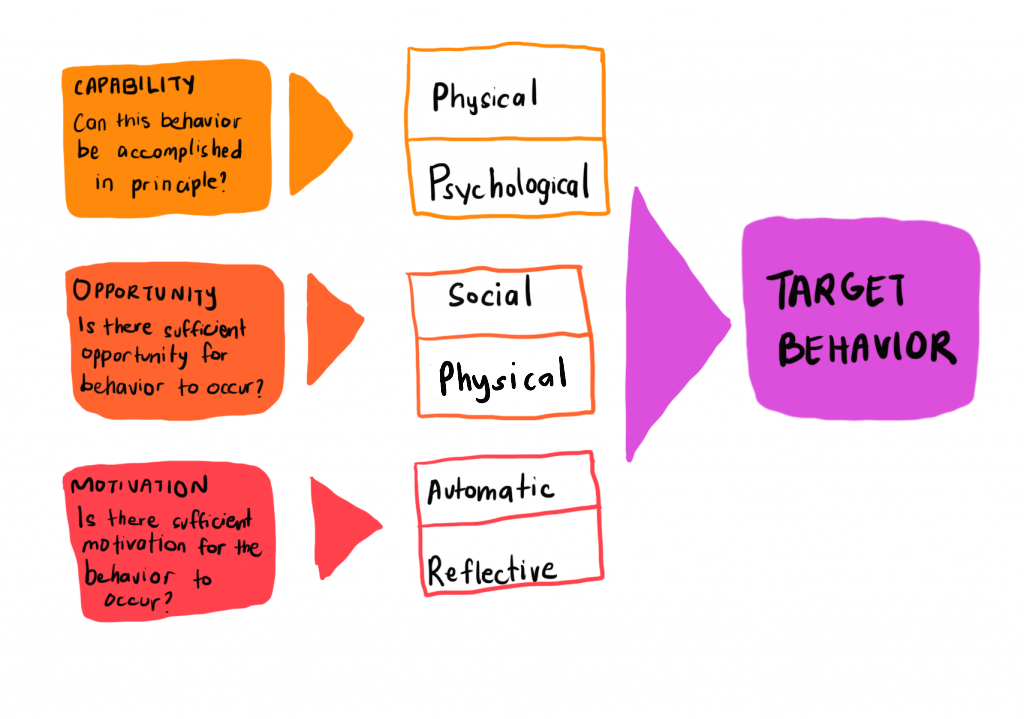The COM-B Model for Behavior Change
What is a Framework?
Behavior change frameworks are the bedrock of applied behavioral science. Designed by behavioral scientists for policy makers and industry leaders, these summaries of cutting edge decision-making insights are essential for applying research in the public and private spheres. Frameworks distill strategies for influencing human decisions into simple, portable mnemonic devices or acronyms. This makes it possible for complex, theoretical insights about how people think and act to make their way into the practices of organizations across every industry and environment. To understand more about how these frameworks work in practice, check out our case studies.

The Basic Idea
The COM-B model for behavior change cites capability (C), opportunity (O), and motivation (M) as three key factors capable of changing behavior (B). Capability refers to an individual’s psychological and physical ability to participate in an activity. Opportunity refers to external factors that make a behavior possible. Lastly, motivation refers to the conscious and unconscious cognitive processes that direct and inspire behavior.5
This model recognizes that behavior is influenced by many factors, and that behavior changes are induced by modifying at least one of these components.5 The COM-B model is particularly important when considering intervention methods, as interveners need to ensure the sustainability of learned behavior. It has generally been used in a public health setting.
How do we effectively create a long-lasting change in behavior?
Theory, meet practice
TDL is an applied research consultancy. In our work, we leverage the insights of diverse fields—from psychology and economics to machine learning and behavioral data science—to sculpt targeted solutions to nuanced problems.
Key Terms
Behavior change interventions: coordinated sets of activities designed to change specified behavior patterns. The patterns may be measured with respect to the incidence of behaviors in specified populations; for example, a behavior change intervention might target a particular high-smoking population to try to decrease daily cigarette intake.5
Behavior change wheel (BCW): a framework designed to aid intervention designers in moving from a behavioral analysis of a problem to an evidence-based intervention method. This framework allows designers to identify intervention functions and policy categories that can bring about change.1
History
The COM-B Model was developed by Susan Michie, Maartje van Stralen, and Robert West in 2011. At the time, many frameworks of behavior change interventions existed, and although many were successful, an overwhelming amount were ineffective. Therefore, Michie and colleagues examined the existing interventions and created the COM-B directly based on earlier frameworks’ limitations. The COM-B model is a piece of the the behavior change wheel framework, also developed by Michie and colleagues (2014).4
People
Susan Michie
A British psychologist and professor of health psychology at University College London. She, along with her colleagues, created the COM-B framework for behavior change. Michie is a member of the Scientific Pandemic Influenza Group on Behavioural Science (SPO-B): 2019 Novel Coronavirus (COVID-19). She was also a recent guest on The Decision Corner podcast, where we discussed the way that behavioral science will shape the world as we emerge from COVID-19.
Consequences
Understanding factors that influence behavior are the key to behavior change. The COM-B model of behavior change proposes that to engage in a behaviour (B) at any given moment, a person must be physically and psychologically able (C) and have the opportunity (O) to exhibit the behavior, as well as the want or need to demonstrate the behaviour at that moment (M). This model is effective because it identifies what component of behavior needs to be changed in order for an intervention to be successful.9 The COM-B is also often used in conjunction with the behavior change wheel, which identifies categories of intervention. In more detail, the three factors are:
- Capability
Recall that capability in the context of COM-B refers to whether we have the knowledge, skills and abilities to engage in a behavior. This capability comprises mental state, knowledge and skills, and physical strength. For example, to make an individual feel capable of performing a behavior or achieving an outcome, implementing a training session to help support learning of that behavior may boost feelings of capability. - Opportunity
Recall that opportunity in the context of COM-B refers to external factors that make execution of a behavior possible. Physical opportunity, opportunities provided by the environment, and social opportunity are all valid components. For example, to improve the opportunity to begin performing a behavior like regular exercise, free training classes may help. - Motivation
Recall that motivation in the context of COM-B refers to the internal processes that influence decision making and behavior. Reflective motivation - the reflective process involved in making plans -and automatic motivation -the automatic processes such as impulses and inhibition - are the two main components. For example, to improve motivation, it his helpful to turn a desired behavior from something they need to do, to something they want to do, by encouraging reflection of the benefits of performing that behavior.
An individual’s behavior will change if the above interventions are successfully implemented.
Controversies
Ogden (2016) argues that limiting human variability by using the COM-B model and behavior change wheel is not necessarily desirable.6 In 2008, researchers began to explore which techniques were used in specific interventions and which were the most effective. They compiled their findings into the Behavior Change Technique Taxonomy, a document that could be used to measure intervention success and ensure implementation of the strongest ones. Ogden argues that variability in people and their interactions was overlooked in the creation of the Behavior Change Technique TaxonomyThose in favor of the Behavior Change Technique Taxonomy movement argue, however, that systematizing behavior allows for the ability to maximize interventions’ effectiveness, which should be the ultimate goal.6
Ogden, however, doubts that information recorded as protocols would make accurate predictions, especially considering human variability. She also notes that if there is divergence between a person’s own beliefs and their behavior, then there is a disconnect between their own behavior and that of the health professional. Moreover, there is a gap between the health professional’s own beliefs and their behavior with a patient. There is further disconnect between the health professional’s beliefs, and the training they received to deliver the intervention.6 Therefore, Ogden argues that human variability is neglected by the aim to systemize behavior change science and its application in intervention development.7 According to her, valuable variability is lost, therefore reducing the effectiveness of behavior change science and its potential to move forward.7
Case study
COM-B behavior model and improving hearing-aid use
Despite an abundance of evidence that hearing-aid use can improve quality of life for the hearing impaired, 30% of the hearing impaired community chooses not to wear them.1 Barker and colleagues (2016) examined whether the application of the COM-B method could be to develop an intervention for this discrepancy. They interviewed 10 audiologists about their feelings on each component of the COM-B model. The audiologists reported that they felt that physical capability was not an issue for them, and both physical and social opportunity were important in determining whether behavioral planning was likely to occur. They also reported that motivation played an important role in determining the likelihood of carrying out behavioral planning. Altogether, capability, opportunity, and motivation were considered to be important drivers in filling hearing-aid fitting appointments. Barker and colleagues therefore argue that the COM-B model can effectively be used in audiology intervention development and provide self-management support.
COM-B behavior model and improving antibiotic usage
Antibiotic resistance is a serious threat to global health, and. is estimated to cause 10 million deaths per year by 2050 if no effective intervention is implemented.3 Duan and colleagues (2020) note that antibiotic resistance is caused by inconsistent use of prescribed antibiotics, often due to poor adherence to physician advice, the sharing of unused antibiotics, and/or the use of antibiotics for self-medication purposes. Unfortunately, understanding of consumer behavior regarding antibiotic usage is limited. Duan and colleagues aimed to examine consumer behavior patterns and develop strategies to improve antibiotic usage in China using the COM-B framework. They identified the COM-B attributes of antibiotic consumers - what capability, opportunity, and motivation looked like - by conducting interviews with 30 participants. Duan and colleagues then developed, tested and validated a measurement to understand antibiotic consumer behaviors. This measurement tool (?) will allow the researchers to categorize and identify hidden behavior patterns of consumers. Duan and colleagues argue that their tool eases the process of developing and applying targeted interventions. For example, a home medicine review program may be useful for consumers who have a tendency to stockpile medicines and self-medicate.3
COM-B behavior model and the COVID-19 pandemic
According to a 2020 review article published by Weston and colleagues, behavioral science plays a critical role in mitigating the effects of infectious disease outbreak, such as the COVID-19 pandemic.11 The World Health Organization (WHO) encourages adaptive behavior change in response to public health emergencies. This sentiment is echoed by Michie and colleagues (2020)2 who state that, “Human behavior will determine how quickly COVID-19 spreads and the mortality. Therefore, behavioral science must be at the heart of the public health response.” Weston and colleagues note that the COM-B model has been proposed as a starting point for interventions that would reduce virus transmission. This idea is further supported by a 2020 paper published in Nature, wherein authors West and colleagues argue that changing behavior is critical to preventing the transmission of COVID-19.10
As we know, behaviors such as social distancing, isolation, wearing a mask, and frequent handwashing are all critical to preventing the spread of COVID-19. These measures have been implemented by governments across the globe, however, according to West and colleagues, there is an urgent need to create interventions that improve human adherence.
The authors employed the COM-B model to understand how capability, opportunity, and motivation affect adherence to COVID-19 guidelines. They also employed the related behavior change wheel to identify the categories of intervention that should be included in the behavior change strategy; education, persuasion, incentivization, coercion, enablement, training, restriction, environmental restructuring, and modelling. West and colleagues found that interventions should target behaviors such as isolation and social distancing measures, specifically. They conclude that behavioral science models and methods, such as the COM-B, can be used to developing and evaluate such interventions.10
Related TDL resources
Stages of Change: How to Motivate and Reinforce Desired Behaviors
If you are interested in learning more about changing human behavior, this article outlines the tool of motivation, as well as how behavior change occurs through a series of stages.
A Nudge a Day Keeps the Doctor Away
If you are interested in reading more about how behavioral science is applied in the medical world, this article outlines how automaticity in our actions may be responsible for sub-optimal health behaviors.
Sources
- Barker, F., Atkins, L., & De Lusignan, S. (2016). Applying the COM-B behaviour model and behaviour change wheel to develop an intervention to improve hearing-aid use in adult auditory rehabilitation. International Journal of Audiology, 55(sup3), S90-S98. https://doi.org/10.3109/14992027.2015.1120894
- Behavioural science must be at the heart of the public health response to COVID-19. (2020, February 28). The BMJ. https://blogs.bmj.com/bmj/2020/02/28/behavioural-science-must-be-at-the-heart-of-the-public-health-response-to-covid-19/
- Duan, Z., Liu, C., Han, M., Wang, D., Zhang, X., & Liu, C. (2020). Understanding consumer behavior patterns in antibiotic usage for upper respiratory tract infections: A study protocol based on the COM-B framework. Research in Social and Administrative Pharmacy, 17(5), 978-985. https://doi.org/10.1016/j.sapharm.2020.07.033
- Michie, S., Atkins, L., & West, R. (2014). The behaviour change wheel: A guide to designing interventions.
- Michie, S., Van Stralen, M. M., & West, R. (2011). The behaviour change wheel: A new method for characterising and designing behaviour change interventions. Implementation Science, 6(1).https://doi.org/10.1186/1748-5908-6-42
- Ogden, J. (2016). Celebrating variability and a call to limit systematisation: The example of the behaviour change technique taxonomy and the behaviour change wheel. Health Psychology Review, 10(3), 245-250. https://doi.org/10.1080/17437199.2016.1190291
- Peters, G. Y., & Kok, G. (2016). All models are wrong, but some are useful: A comment on Ogden (2016). Health Psychology Review, 10(3), 265-268. https://doi.org/10.1080/17437199.2016.1190658
- Social Change UK. (n.d.). A guide on the COM-B Model of Behaviour. https://social-change.co.uk/files/02.09.19_COM-B_and_changing_behaviour_.pdf
- West, R., & Michie, S. (2020, April 9). A brief introduction to the COM-B Model of behaviour and the PRIME Theory of motivation. https://www.qeios.com/read/WW04E6.2
- West, R., Michie, S., Rubin, G. J., & Amlôt, R. (2020). Applying principles of behaviour change to reduce SARS-Cov-2 transmission. Nature Human Behaviour, 4(5), 451-459. https://doi.org/10.1038/s41562-020-0887-9
- Weston, D., Ip, A., & Amlôt, R. (2020). Examining the application of behaviour change theories in the context of infectious disease outbreaks and emergency response: A review of reviews. BMC Public Health,20(1). https://doi.org/10.1186/s12889-020-09519-2
About the Authors
Dan Pilat
Dan is a Co-Founder and Managing Director at The Decision Lab. He is a bestselling author of Intention - a book he wrote with Wiley on the mindful application of behavioral science in organizations. Dan has a background in organizational decision making, with a BComm in Decision & Information Systems from McGill University. He has worked on enterprise-level behavioral architecture at TD Securities and BMO Capital Markets, where he advised management on the implementation of systems processing billions of dollars per week. Driven by an appetite for the latest in technology, Dan created a course on business intelligence and lectured at McGill University, and has applied behavioral science to topics such as augmented and virtual reality.
Dr. Sekoul Krastev
Sekoul is a Co-Founder and Managing Director at The Decision Lab. He is a bestselling author of Intention - a book he wrote with Wiley on the mindful application of behavioral science in organizations. A decision scientist with a PhD in Decision Neuroscience from McGill University, Sekoul's work has been featured in peer-reviewed journals and has been presented at conferences around the world. Sekoul previously advised management on innovation and engagement strategy at The Boston Consulting Group as well as on online media strategy at Google. He has a deep interest in the applications of behavioral science to new technology and has published on these topics in places such as the Huffington Post and Strategy & Business.





